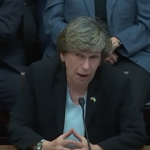Inflated Grades: What Happens When Report Cards Lie
On November 8, the Thomas B. Fordham Institute held an event which dealt with the issue of grade inflation in U.S. schools. The National Assessment on Educational Progress (NAEP) has shown that only about a third of high school seniors are academically prepared for higher education. This is in spite of the fact that some of these students have GPA’s that would indicate otherwise. Adam Tyner, associate director of research at the Thomas B. Fordham Institute, Michael Hurwitz, Senior Director of the College Board, and Bailey Cato Czupryk, a Partner at TNTP, discussed the causes and consequences of inflated grades and possible solutions.
Tyner discussed the results of a study by Fordham entitled Grade Inflation in North Carolina’s High Schools. This study looked at the grades students received in Algebra in North Carolina high schools. He said: “…grades can be misleading… for the superior level-really the mastery level-only about a fifth of A students meet that high bar…” and “…a majority of B students don’t meet the college and career ready standard and more than a third of them don’t even meet the simple proficiency standard.” The study also showed that median cumulative GPAs have increased, and this has occurred primarily in affluent schools.
Hurwitz said that the situation in North Carolina schools was representative of some other schools in the U.S.: “There is now sort of a confluence of studies that demonstrate the exact same phenomena. High school grades are increasing, and they are increasing more rapidly at wealthy schools. There was a study put out several years ago by the U.S. Department of Education that…showed between about 1990 and 2009 average high school GPA’s of graduates increased by .32 GPA points. It’s a very sharp increase and over that time there wasn’t any increase in NAEP scores.” He also pointed out that not all schools were inflating grades, but the fact that certain schools did not inflate grades while others did inflate grades meant that it has become difficult to interpret what getting an A grade really indicates.
Czupryk said that a consequence of grade inflation is that “…the kids are suffering because they fundamentally believe the signals that we as grownups are sending them about how ready they are( for college).” Tyner agreed with this point and expanded upon it: “This is not a victimless crime. I mean, giving easy A’s and having low standards for students-they are not going to learn as much, they are not going to work as hard. There’s research on this that college-level students who are in classes where they expect to get an A work a lot less.”
The panelists offered possible solutions to the grade inflation problem. Tyner said: “…holding the line is something we can do by having states or districts actually create some incentives for them(schools/teachers) to hold the line rather than all the incentives being towards higher graduation rates and things that aren’t really externally validated…having external validation-and that can come in the form of stuff like EOC’s(End of Course Tests)-and that can also come from other kinds of auditing that the states can do to see if grades are getting out of whack…” Czupryk said: “…if state test data came out sometime before November of the next school year, we could actually support parents and families…there’s a more holistic perspective about your child here and let’s dig into that and talk about what I-as the person who’s leading your child- needs to do to support your child to be successful.”




